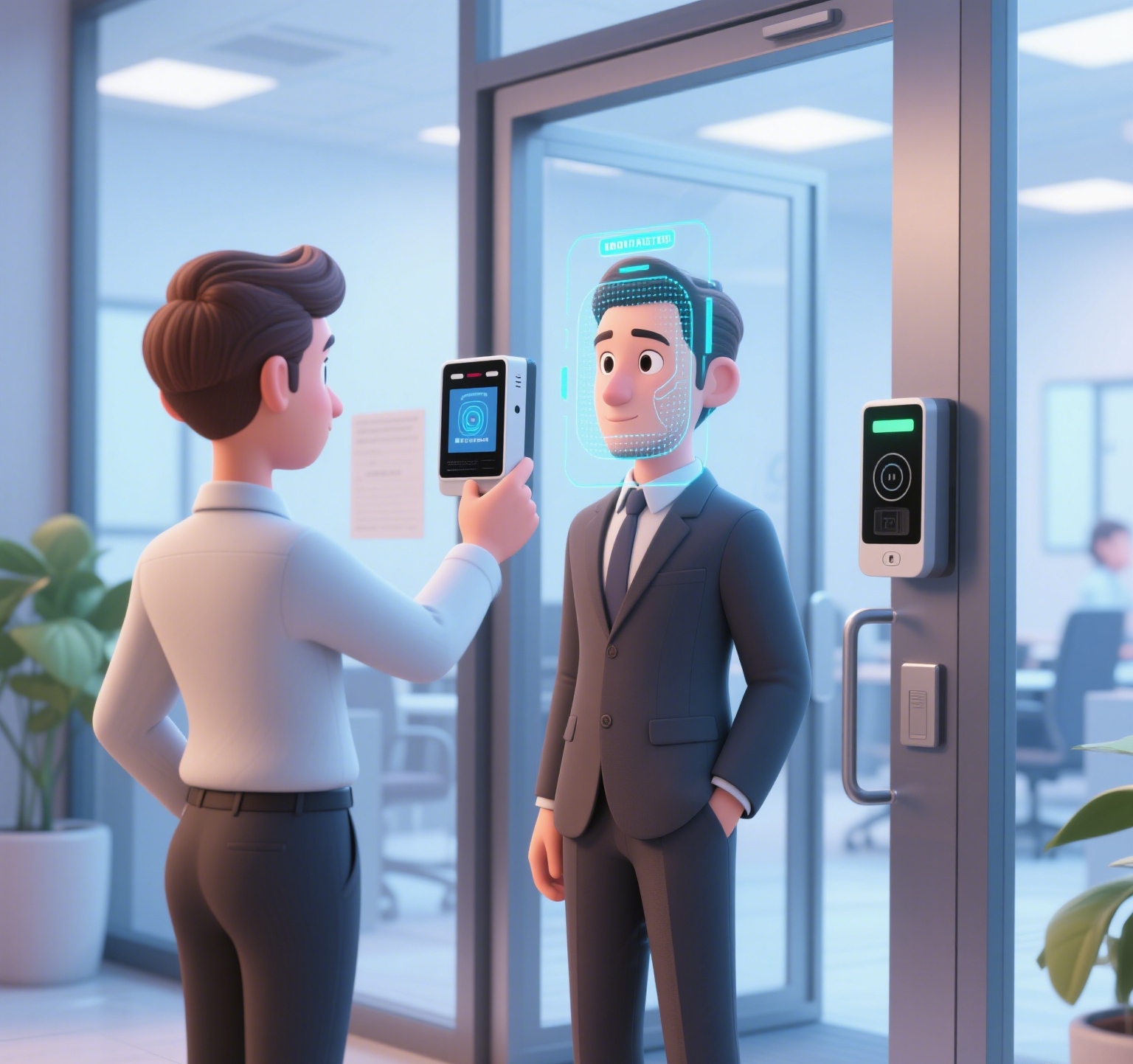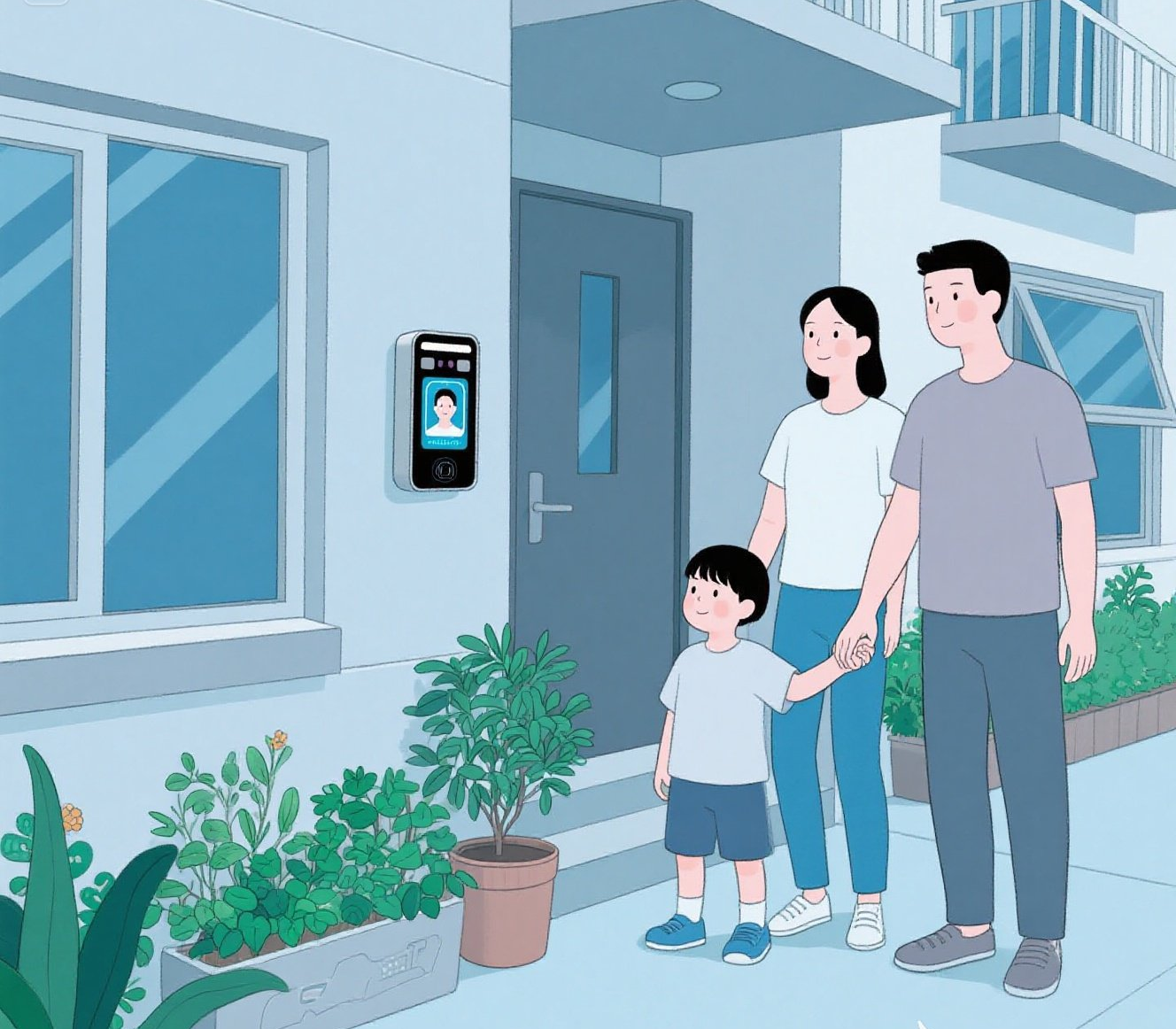This article explains what a facial recognition control system is, how it works, its core features and benefits, its limitations, and where it fits into today’s applic
What Is a Facial Recognition Control System?
أ facial recognition control system is a type of biometric access control solution that verifies a person’s identity based on their unique facial features. Unlike traditional systems that require keys, PINs, or cards, التعرف على الوجه uses AI-powered cameras and software to authenticate users in a touchless, efficient, and secure manner.
These systems are commonly used for:
Door and gate access control
Time attendance tracking
إدارة الزوار
Surveillance and identity verification
By converting a person’s face into a digital signature and comparing it with a stored database, the system determines whether access should be granted or denied—usually in under a second.
How Does a Facial Recognition System Work?
ال facial recognition process generally involves the following steps:
Image Capture
A camera captures a live image or video of a person’s face as they approach the system. This can be done through surveillance cameras, door-mounted readers, or mobile devices. High-resolution image capture is essential for accurate recognition.
الكشف عن الوجه
The system automatically detects and isolates the human face within the frame. It distinguishes facial features from the background and ensures the image is suitable for analysis. This step also filters out non-human objects or multiple faces.
Feature Extraction
Once the face is located, the system analyzes key facial landmarks—such as the distance between the eyes, nose width, cheekbone structure, and jawline. These unique measurements are extracted and converted into a digital template known as a faceprint.
Face Matching
The extracted faceprint is then compared against a database of stored facial templates. The system uses AI algorithms to determine if there’s a match between the captured face and any pre-registered identities.
Access Decision
If the face matches a stored and authorized identity, the system grants access automatically. If there’s no match or the person is not authorized, access is denied. This process usually takes less than a second, providing fast and secure entry.
This biometric process is widely used in facial recognition attendance systems, smart access control, and border security, ensuring both convenience and high-level protection.
Key Features of Facial Recognition Control Systems
Real-Time Face Detection
Real-time face detection is the core of any advanced facial recognition control system. It enables the system to instantly detect a human face within the camera’s frame, even when people are walking quickly or in crowded environments.
Modern systems use infrared sensors و 3D imaging technology to capture facial landmarks precisely, ensuring high accuracy regardless of facial angle or lighting conditions. This immediate processing allows for fast, seamless entry without slowing down foot traffic—ideal for offices, airports, or schools during rush hours.
Liveness Detection
اكتشاف الفعالية is a critical feature that protects facial access control systems from spoofing attacks. Without it, a printed photo, a video on a phone, or a 3D face mask could potentially fool the system.
With AI-based liveness verification, the system analyzes subtle facial movements—such as blinking, head tilts, and texture depth—to determine whether the detected face belongs to a live human being. This ensures that only genuine users are authenticated, strengthening identity security and reducing fraud.
AI-Powered Matching Algorithms
At the heart of a reliable facial recognition system is an intelligent AI matching engine. It uses machine learning و deep learning algorithms to build a unique facial signature from biometric data points.
Over time, the algorithm learns to accommodate slight changes in appearance—such as facial hair, glasses, aging, or different lighting—resulting in consistently accurate matches. High-end systems can recognize faces from various ethnic backgrounds and age groups, making them more inclusive and suitable for global deployments.
Cloud or On-Premise Deployment
Every organization has different data security requirements. A flexible facial recognition control system offers both cloud-based و on-premise deployment options.
Cloud-based facial access control allows remote management, software updates, and real-time data syncing across multiple locations—ideal for companies with distributed offices.
On-premise systems, on the other hand, provide greater control over sensitive biometric data, ensuring compliance with privacy regulations like GDPR or local cybersecurity laws.
This adaptability helps businesses align their biometric access system with IT infrastructure and privacy policies.
Third-Party System Integration
An advanced facial recognition terminal should seamlessly integrate with third-party platforms to become part of a complete access control ecosystem. This includes:
Access control panels
Employee attendance software
HR management systems
Visitor management platforms
Building automation systems (BAS)
Such integration enables centralized control, automated workflows, and synchronized reporting. For example, when an employee clocks in using facial authentication, their time can be automatically logged in the company’s HR system.
Mobile and Remote Access
Today’s facial recognition systems often come with mobile-friendly dashboards و remote monitoring capabilities. System administrators can manage access rights, receive alerts, view logs, and monitor real-time footage—all from a mobile app or web interface.
This feature is especially useful for:
Facility managers overseeing multiple entry points
Security teams needing instant breach alerts
IT departments updating permissions on the go
Remote control not only improves convenience but also adds an extra layer of responsiveness to your security infrastructure.
Benefits of Facial Recognition Control Systems
Touchless Authentication
Facial recognition systems enable completely contactless access without the need for physical cards, PIN codes, or fingerprint scanning. Users simply approach the entrance, and the system identifies their face automatically. This not only improves hygiene—especially important in high-traffic areas such as offices, hospitals, and airports—but also reduces the risk of spreading germs through shared surfaces. Touchless authentication enhances user convenience while supporting public health measures.
Fast and Efficient Entry
The facial verification process usually takes less than one second to complete, allowing rapid identification and access. This speed helps reduce queues and congestion at busy entry points like gates, doors, or turnstiles, making it ideal for workplaces, educational campuses, and transportation hubs. Fast processing also improves overall operational efficiency and user throughput, ensuring smooth daily operations.
Higher Security Standards
Facial biometrics provide a much stronger security layer compared to traditional methods such as ID cards or passwords, which can be lost, stolen, or shared. Because each face is unique, the risk of identity fraud or unauthorized access is significantly minimized. Modern facial recognition systems also incorporate liveness detection to prevent spoofing with photos or videos, further enhancing security reliability.
Cost-Effective in the Long Run
Although the initial investment in facial recognition technology might be higher than conventional access methods, the long-term savings are substantial. Organizations reduce expenses related to issuing and replacing lost or stolen cards, manual identity checks, and administrative tasks. Additionally, automated access control reduces the need for security personnel to verify identities, lowering labor costs.
تحسين تجربة المستخدم
By offering seamless and frictionless access, facial recognition systems increase satisfaction for employees, visitors, and customers alike. Users appreciate the convenience of quick, effortless entry without fumbling for cards or remembering PINs. This positive experience contributes to better compliance with security policies and fosters a more modern, tech-friendly environment.
Challenges and Limitations of Facial Recognition Access Control
Despite its advantages, facial recognition technology also comes with challenges:
Privacy Concerns
Facial recognition involves collecting and storing biometric data, which raises privacy issues. Users may worry about how their data is used or shared. To address this, organizations must follow data protection laws like GDPR, use encryption, and ensure user consent to build trust and stay compliant.
Lighting and Environmental Limitations
Facial recognition accuracy can drop in poor lighting or when users wear masks, hats, or glasses. Although modern AI has improved, proper camera placement and lighting are still important to ensure reliable performance in different environments.
Accuracy and Fairness Across Diverse Populations
Some systems may be less accurate with different skin tones, ages, or facial features. This can lead to false rejections or bias. Choosing a reliable provider that uses diverse training data helps improve accuracy and fairness for all users.
Where Are Facial Recognition Control Systems Used Today?

Corporate Offices
Facial recognition is widely used in modern office buildings for employee access control. It replaces traditional ID cards and enables touchless, secure entry to workspaces, meeting rooms, and restricted zones.

Airports and Border Control
Many international airports use facial recognition to speed up immigration checks and boarding processes. It enhances both security and efficiency by verifying passenger identities in real time.

Schools and Universities
Educational institutions use facial recognition to control access to campuses, classrooms, and dormitories. It also helps automate attendance tracking and restrict unauthorized entry.

Hospitals and Healthcare Facilities
In medical centers, facial recognition helps manage staff and visitor access to sensitive areas like operating rooms and drug storage zones. It also reduces contact for better hygiene.

Residential Communities and Smart Homes
Gated communities and smart buildings use facial recognition for resident access, visitor management, and lobby security. It offers convenience and real-time monitoring for property managers.

Government and Law Enforcement
Police stations, government buildings, and public safety departments use facial recognition to secure entrances, verify personnel, and monitor high-risk areas with surveillance integration.
خاتمة
Absolutely. The facial recognition control system offers an effective, scalable, and smart way to manage access across various environments. By combining speed, hygiene, and high-level security, it helps organizations enhance operational efficiency while keeping people safe.
However, like any technology, it’s crucial to implement it ethically, with a focus on user privacy, system accuracy, and secure data management.
التعليمات
Facial detection simply identifies that a face is present, while التعرف على الوجه goes further to identify and match the face with a database.
Many modern systems support mask detection and recognition, though accuracy may slightly decrease depending on the algorithm.
While no system is 100% immune, advanced facial recognition systems use encryption, liveness detection, and secure data storage to prevent hacking and spoofing.
Facial data is usually stored as encrypted mathematical templates, not raw images, reducing the risk of misuse.
Yes, as long as the system uses infrared or 3D imaging technology, it can work in varying light and weather conditions.

